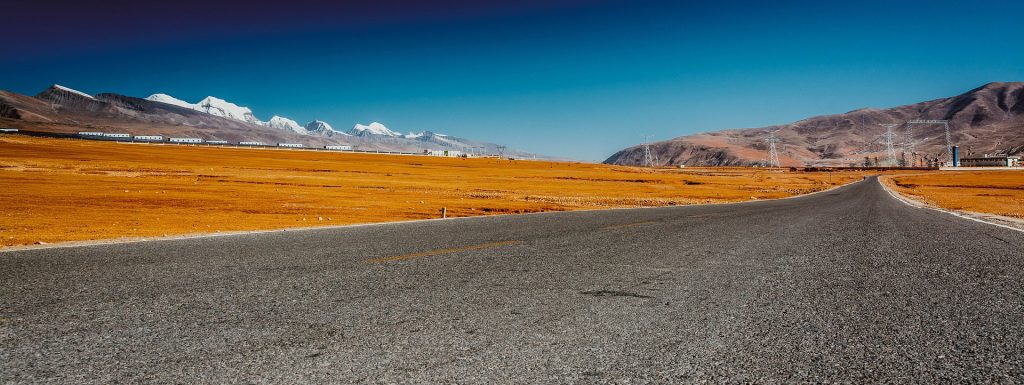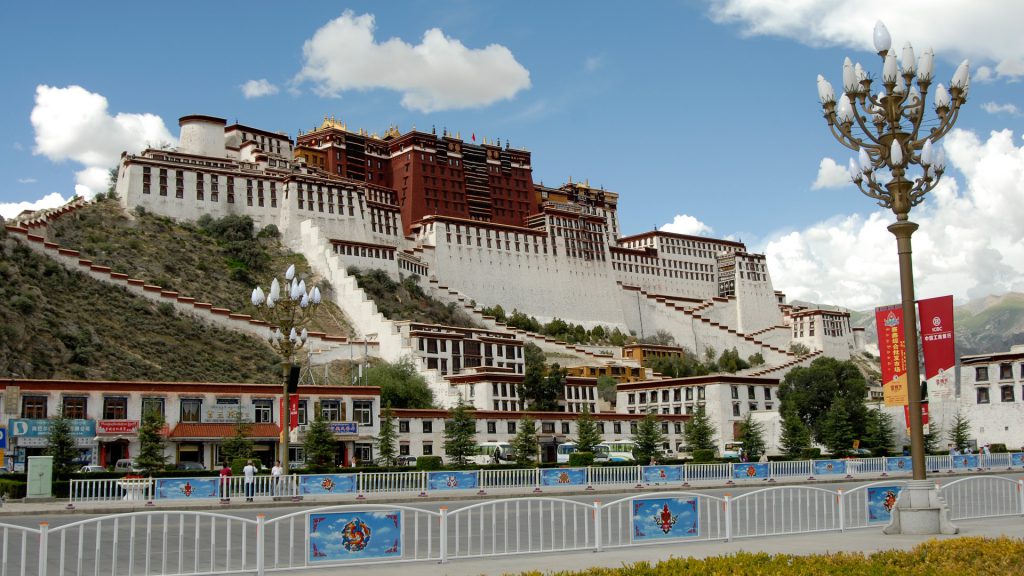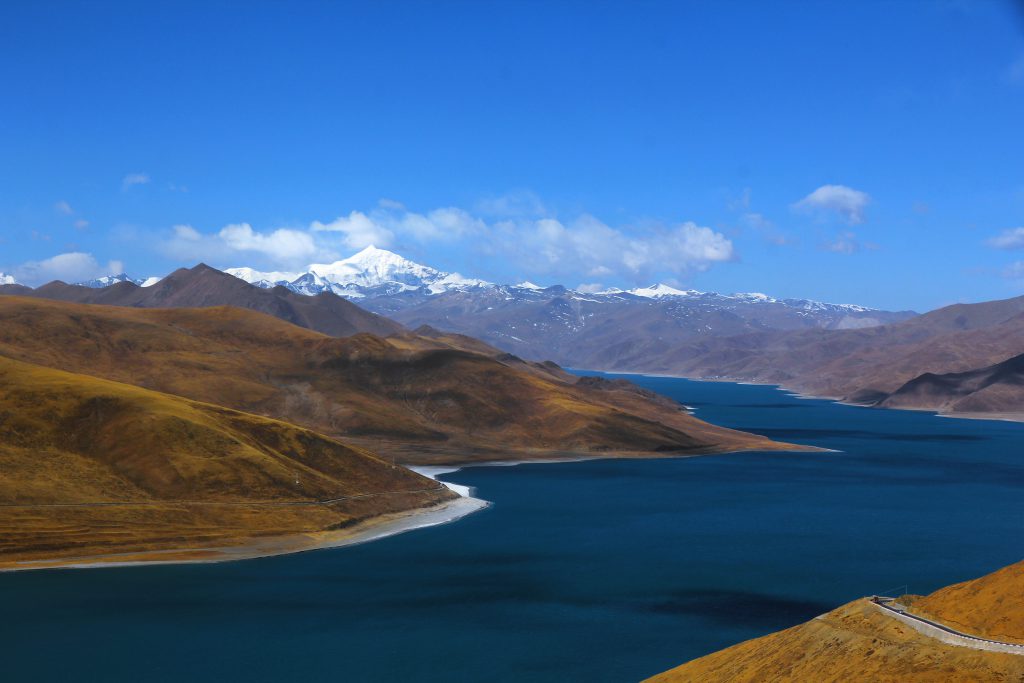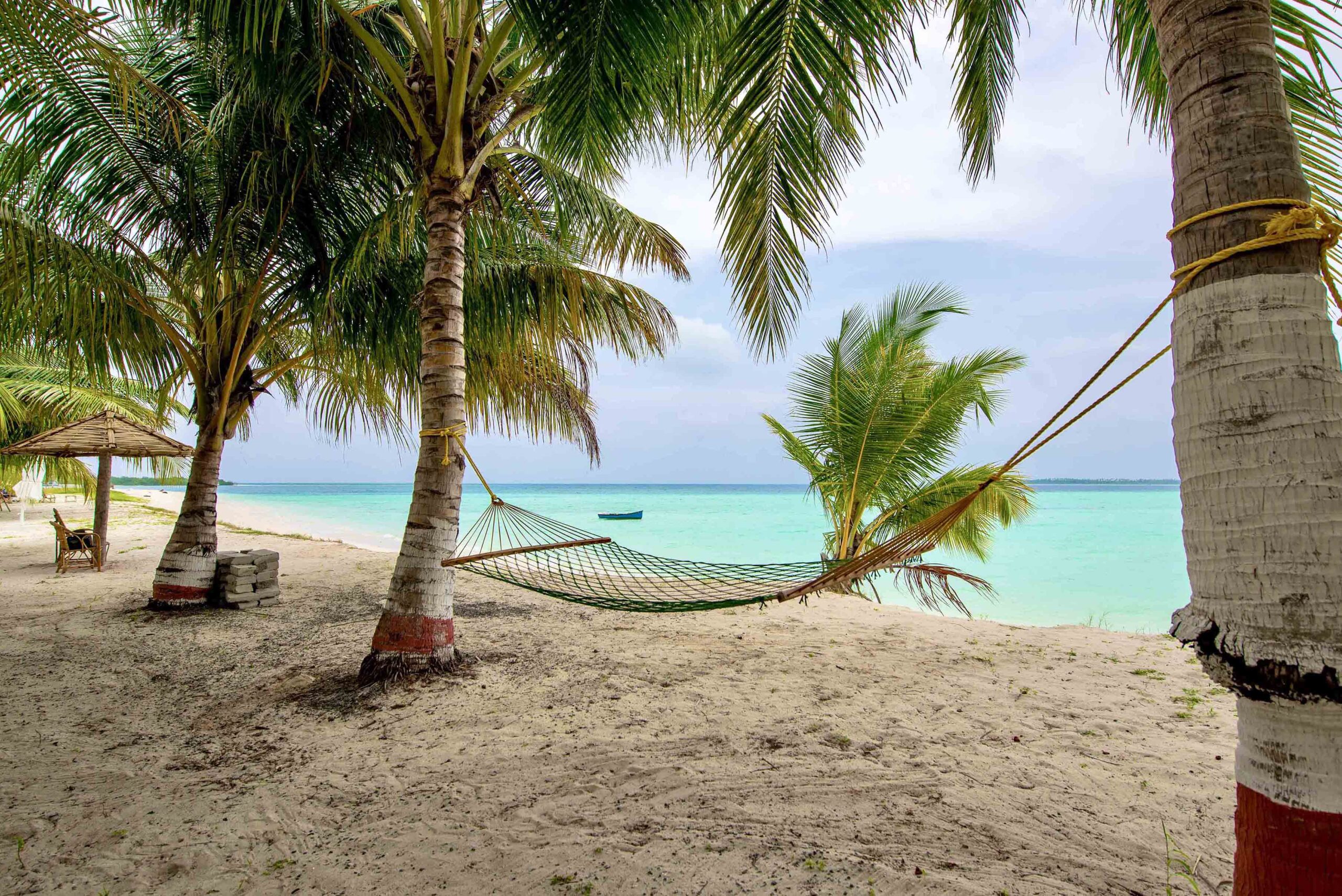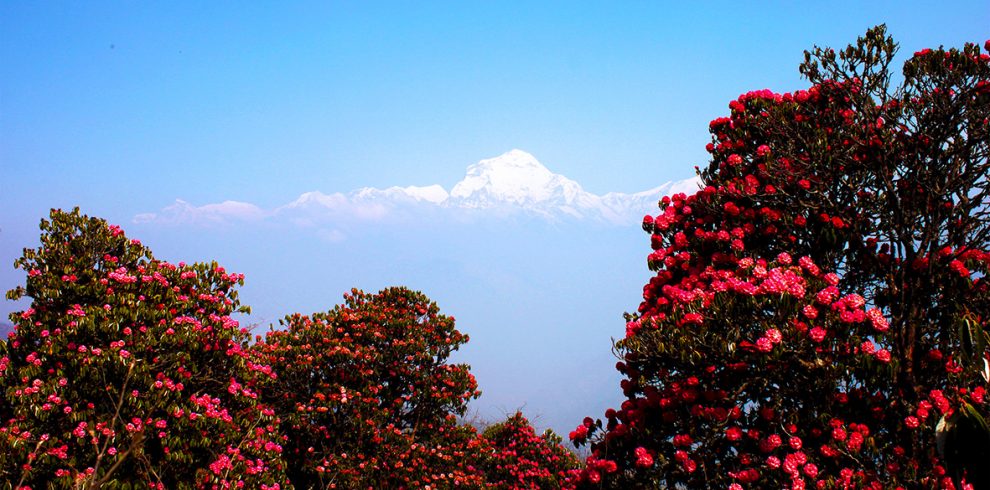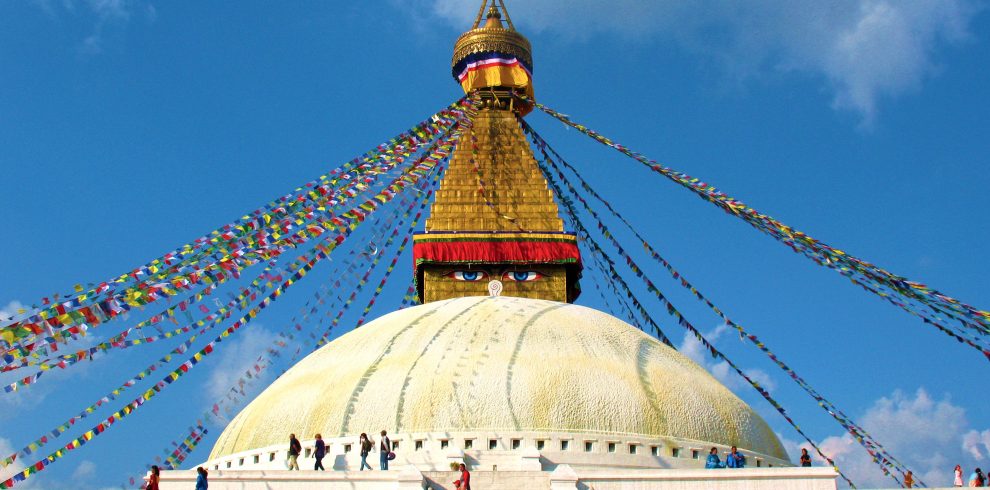Tibet is the highest region in the world, at an average elevation of 4,300 m. Blocked by vast mountain ranges in the North, South and west, it is one of the world’s least populated areas. Tibet Autonomous Region, the mystic Shangri-la, the forbidden kingdom on the Roof of the world, has captured imagination for centuries. Great explorers and adventurers of the century have ventured into this holy land rendered inaccessible by the hostile natural conditions and bandits that waylaid them across through the Himalayas.
Overview
Tibet’s past grandeur, majesty, magic and mystery still remain undiminished. One can still see today nomads herding their yaks, pilgrims worshiping at sacred shrines, as well as the expansive, striking and enduring Himalayan topography.
When China launched its new “open-door-policy” in the early 1980’s, tourism of the Tibet Autonomous Region has seen a rapid development in tourism. Over the last 34 years, Tibet has attracted thousands of visitors, mountaineers, and explorers from over 60 countries and regions. The accommodation and transportation facilities for tourism have been greatly upgraded.
Tibet is truly an adventurer’s paradise! It has been a source of inspiration for sages and ordinary people of all time. Tibet enjoys rich travel resources, including Mt. Qomolangma (Mt. Everest) the highest peak in the world on the Sino- Nepalese border, the winding Yarlong Tsangpo River with the Brahmaputra Great Gorge, and the Holy Mt. Kailash and Mansarovar lakes, as well as ancient ruins, palaces and monasteries, folkloric activities and religious ceremonies.
Highlights
- Trans Himalayan flight from Kathmandu to Lhasa giving you an aerial view of Mt. Everest.
- Potala Palace towering over the entire Lhasa valley
- Sightseeing of Lhasa
- Drepung Monastery- the largest monastic university in Tibet
- Tashilhumpo monastery- the seat of Panchen Lama
- Everest Base Camp from the North side
Itinerary
Once you reach KTM airport and finish with the immigration and custom formalities be prepared to confront the confusion outside the airport which is common in most of the south Asian countries. As you walk out of the Exit door into the passenger pick up area you will see hundreds of people with different sign boards in their hands, taxi drivers looking for fares, hotel touts looking for customers and porters trying to help with the luggage for tips. Please remain calm and do not walk out of the restricted area into the crowd straight away. Remain there and try to find the Hi On Life Adventures sign board. Once you spot it, walk straight to the signboard and identify yourself. From here we will take care of you.
When you arrive to your hotel you will be briefed about your activities and “do’s and don’ts” while your stay in Kathmandu. We will also collect some documents from you. Please have the following things handy when arriving.
Travel/ Medical Insurance (photo copy)
4 passport size photos
Original Passport for Tibet Visa application.
In the evening we will go for a traditional Nepali dinner at Kathmandu’s finest Nepali restaurant.
Kathmandu, the capital city of Nepal was once thought to be the fabled and inaccessible Shangri-La. It is now a hub for independent travelers as well as a growing vacation spot catering to all budgets. The city with a population of 2.5 million stands at an elevation of approximately 1,400 meters (4,600 ft) in the bowl-shaped Kathmandu Valley of central Nepal. It is surrounded by four major hills: Shivapuri, Phulchoki, Nagarjun, and Chandragiri. Kathmandu was ranked third among the top 10 travel destinations on the rise in the world by TripAdvisor and ranked first in Asia.
We begin with an early morning Yoga session. After breakfast, while our representative are working for your visa application, we will explore and experience the grandeur of the ancient Hindu and Buddhist culture and architecture, and the finesse of the ancient traditional Newari craftsmanship in their temples. This guided tour is focused on presenting you the history and culture of the Kathmandu valley.
Pashupatinath Temple, also a UNESCO World Heritage Site, is the biggest temple of the Hindu god Shiva. It is situated at the bank of the holy river Bagmati. This pagoda style Hindu temple is made by bronze that has four doors in four directions with a golden pinnacle at the top with gold-glided ruff. There is no record when the temple was first built but according to Hindu text, the existence of this temple has been since the second century.It is also famous for its cremation grounds called “Aryaghat”at the bank of Bagmati River. Most of the Hindu people in the valley are cremated in this place after their death.
Bouddhanath Stupa, built in the 5th century, is the biggest Stupa in South Asia. It is about 40m high and about 488m in circumference, surrounded by the brick wall. The stupa is essentially a large dome and on the top is a cubicle structure with paintings of the eye’s of Buddah which represent the enlightened state of compassion and wisdom. There are 13 spires around the cube representing the 13 tasks the Buddhists must perform to reach enlightenment. The stupa is located at the ancient trade route to Tibet where Tibetan merchants rested and offered prayers have for many centuries. It is also a UNESCO world heritage site.Lunch at The OR2k vegetarian restaurant
Kathmandu Durbar Square, a “UNESCO World Heritage Site” lies in the heart of old Kathmandu city in Basantapur. It holds held the palaces of the Malla and Shah kings who ruled over the city. Once the residence of Nepal’s Royal family, all coronation ceremonies were held here. There were 50 temples within the vicinity including the temple of the titular deity, Taleju Bhawani, a number of which were destroyed during the 2015 earthquake that devastated the country killing more than 10,000 people. The Durbar is divided into two courtyards, the outer Kasthamandap, Kumari Ghar, and Shiva-Parvati Temple, and the inner section consisting of Hanuman Dhoka and the main palace. The Durbar Square, with its old temples, palaces, epitomizes the religious and cultural life of the people.
While we wait to get the visa for Tibet, we take this opportunity to visit another ancient town in the Kathmandu Valley.
Bhaktapur Durbar Square, a UNESCO World Heritage Site, is one of the most captivating architectural showpieces of the Valley as it highlights the ancient arts of Nepal. It is situated in Bhaktapur, which used to be the largest of the three Newar kingdoms of the Kathmandu Valley, and was the capital of Nepal during the great Malla Kingdom until the second half of the 15th century. The Square consists of pagodas and shikhara style temples and stone monoliths perched with golden effigies that surround the main palace of brick and wood. It is also famous for beautiful wood carvings in every gateways and windows. The Golden Gate is said to be the most beautiful and richly moulded specimen of its kind in the entire world. We will have lunch at Bhaktapur and drive back to Kathmandu in the afternoon.
Flight: 1 hour 45 mins
Drive airport to Lhasa: 62 kms, 1 hour
Depending on your flight time, we drive to Tribhuwan International Airport 3 ½ hours before departure time. The flight form Kathmandu to Lhasa is probably one of the most beautiful mountain flights in the World. This 90 mins flight flies east of Kathmandu and then turn North and fly at around 35,000 ft (10,600m) between Mt. Everest 8848m and Mt. Makalu 8481m (the 5th Highest mountain in the world)Upon arrival at Gongar airport, our representative in Lhasa will receive us and drive to Lhasa which is 64 kms from the airport. We check in to our hotel and have a relaxing afternoon. Drink as much as possible and refrain from any strenuous activity to help your body to get acclimatized to the high altitude quicker. We take an easy day today and wind up with a welcome dinner at one of the finest traditional Tibetan restaurants.
Today we visit some of the most historic places of Lhasa:
The Potala Palace, the palace of the Dalai Lama is built high on a hill called Marpori located in the center of Lhasa city. The palace has 13 stories, which are built entirely of mud and wood, containing 1000 chapels. There are gold-embossed tombs of past Dalai Lamas, one of which is called Zamling Yeshag which is believed to contain tremendous amount of gold, precious gems, and countless artifacts in the tomb.
Sera Monastery is one of the 3 famous monasteries in Lhasa along with the Drepung Monastery and the Ganden Monastery. It was built by Sagya Yeshes, one of the 8 disciples of Zongkapa, founder of the Gelug Sect of Tibetan Buddhism. In 1414, Zongkapa sent Sagya Yeshes to pay homage to Emperor Chengzu of the Ming Dynasty in today’s Nanjing of East China’s Jiangsu Province. The Emperor granted him the title of the Great Mercy Prince of Dharma. After he returned to Tibet, he followed Zongkapa’s instruction to build the Sera Monastery in 1419.
Please Note- Lunch will be provided wherever convenient during the sightseeing.
In the late afternoon, we come back to our hotel and get refreshed. In the evening we will dine at another fine restaurants in Lhasa.
Drepung Monastery – Once the Largest MonasteryDrepung Monastery was the largest monastery of Tibet constructed in 1416. There were a total of 10,000 monks who once lived here. Drepung Monastery plays an important role in Tibet Buddhism. Located on the Gambo Utse Mountain, it has magnificent complex of white buildings dotted around the hillside. The Ganden Potrang, once the residence for Dalai Lamas (1-5th) before the 5th Dalai Lama built Potala Palace, is the most featured historical building here, which allows Drepung Monastery enjoy the highest status among Tibet monasteries.
Jokhang Temple – Religious center of TibetJokhang Temple (or Jokhang Monastery) is the spiritual center of Tibet and the holiest destination for all Tibetan pilgrims. It is listed in the World Cultural Heritages with Potala Palace and Norbulingka. It is situated at the heart of the old town of Lhasa and surrounded by Barkhor Street. This 4 storied building, built in the 7th century by Songtsan Gambo, with roofs covered with gilded bronze tiles, demonstrates a combination of the architectural style of Han, Tibetan, India and Nepal, as well as a Mandala world outlook of Buddhism. It was originally called the ‘Tsuklakang’ (Tsulag Khang) – ‘House of Religious Science’ or ‘House of Wisdom’ during the Bon period of Tibet, which is referred to geomancy, astrology, and divination of Bon. Today it is more commonly known as the Jokhang, which means the ‘House of the Buddha’. PN- Lunch and dinner will be provided in some of the best restaurants in Lhasa.
In the evening we take a walk along the famous Barkhor square. Located in the old area of Lhasa City, Tibet, Barkhor Street is a very ancient round street surrounding the Jokhang Temple and the locals are always proud of it. As a symbol of Lhasa, it is also a must-see place for visitors.
We end this beautiful day with a nice dinner at the hotel.
Distance: 260 kms
Driving time: 5 hours
We drive over the Gampala passes, and descend down to the shores of Yamdrok-tso (4400m). Yamdrok Lake is a freshwater lake. It is over 72 kms long making it one of the three largest sacred lakes in Tibet. The lake is surrounded by many snow-capped mountains and is fed by numerous small streams and in the distance you can have spectacular views of Holy Mount Nyenchen Khangsar, (7191m)
After the lake, we will pass the Karola Glacier and Manak Dam Lake. We arrive Gyantse in the afternoon. Gyantse is Tibet's third largest city (after Lhasa and Shigatse).In Gyantse, we will visit the famous Pelkor Monastery and Gyantse Kumbum. The main temple of Pelkor Chode, the Tsuklakhang was built 1418 – 1425 by the 2nd prince of Gyantse. It was an eclectic academy with 16 dralsang (colleges) belonging variously to Sakya, Butonpa, Geluk and Kagyu schools.
Distance: 93 kms
Driving time: 1 hour 45 mins
It is a pleasant and scenic drive to Shigatse. Upon arrival at Shigatse we will visit Tashilumpo which is the seat of the Panchen Lama, second only in importance to the Dalai Lama. It was founded by Gendun Drup, the 1st Dalai Lama in 1447. The monastery is located on a hill at the center of Shigatse city, the second largest city in Tibet. There is a 21.6m wooden statue of Maitreya, the future Buddha and elaborate, jewel encrusted reliquary chorten.
Afternoon will be free to visit the old Tibetan market and walk around the city.
Distance: 320 kms
Driving time: 4 hour
Today we cross over 2 big passes, Tsola Pass(4600) and Gyatsola Pass(5248M). Youyou’re your first view of Mt. Everest from this pass. We arrive Xegar in the afternoon.
Xegar is a new Chinese commune built at the foot of the ruins of Xegar Dzong. With a population of 3000, its importance lies in the fact that it is the centre of this large and remote country and also a base from where expeditions to Mt. Everest and other peaks are launched.
Distance: 85 kms each way
Driving time: 1 hour 45 mins each way
Rongbuk to Everest Base Camp: 7 kms, 30 mins in horse cart each way
We drive through Pangla pass 5000m from where you will have a fantastic view of Mount Everest, Lhotse and Makalu which are over 8000m. Upon arriving at Rongbuk, we will visit the monastery which is the world’s highest monastery. After lunch we will hire a horse cart to takes us ona ride to Everest Base Camp. We are not allowed to enter the Base camp area, but we can explore the surrounding area. In the evening we will drive back to Xegar.
Distance: 237 kms
Driving time: 4 hours
Distance: 267 kms
Driving time: 4 hours 30 mins
Today we end this soul replenishing trip in Tibet, and after an early breakfast we drive to Gongar airport and say good bye to our Tibetan friends to catch our onward flight back to Kathmandu. Upon arrival to Kathmandu, we check in to our hotel.
We will have a farewell dinner at one of the restaurants in Kathmamdu.
Depending on your flight time, we will drive to the airport 3 ½ hours before time of departure. Trip ends.
Cost Includes
- All internal transportation, in private vehicle, both in Nepal and Tibet.
- Welcome dinner.
- Use of a personal duffle bag.
- Services of English or/and Swedish speaking tour leader (8 pax and above)
- Services of English speaking Tibetan guide.
- 4 nights in tourist class hotel on twin share bed and breakfast basis while in Kathmandu.
- All accommodation in tourist class hotel on twin share bed and breakfast basis while in Tibet.
- International return flight Kathmandu/ Lhasa/ Kathmandu
- All necessary Tibet travel permits
- Chinese visa fee
- Everest National Park admission fee
- All fees for sightseeing and visits to monasteries as outlined in the itinerary
- All applicable taxes and service charges
Cost Excludes
- Nepalese Visa costs
- Personal accident and rescue insurance. You must provide your own rescue insurance
- Mineral water, beer, soft drinks and extra tea/coffee outside of normal meal times.
- Private room accommodation unless a single supplement is paid.
- Optional tips to guides and driver.
- Meals other than breakfast in Tibet
- Tips for guides and driver
Map
Tibet at a glance:
Population: 3.03 million (2011)
Area: 1,228,400 km²
Capital city: Lhasa
Highest elevation: 8848 m (Mt. Everest) shared with Nepal.
Average elevation: 4300 m
This Epic journey into a centuries- old culture, high mountain passes, ancient monasteries and fortresses from a bygone era, gives you an unforgettable experience.
The breath-taking trans- Himalayan flight from Kathmandu to Lhasa offer truly spectacular views of the Himalaya, gives you an opportunity to have an aerial view of Mt. Everest and other towering peaks (weather permitting).
The North face of Mt. Everest dominating the skyline as seen from Everest Base Camp is truly awe-inspiring.
High Altitude
Tibet also known as the roof of the world has an average altitude of 4000m. Even when we land in Lhasa, we are already above 3600m. Hi On Life’s itinerary has been carefully designed to minimize the effects of altitude. We ascend slowly and surely allowing enough time for safe acclimatization. Headaches and breathlessness are common at altitude which in itself is nothing to worry about. In rare cases, this may worsen to Acute Mountain sickness (AMS), so a close watch is kept on all trekkers by the group leader who is trained to recognize the symptoms of AMS which are severe headaches, nausea, lethargy, loss of appetite serious breathlessness even at rest. If any trekkers show such signs they will be descended to relatively lower and safer altitude. The Group Leader’s decision on evacuating such person to a safe altitude is final. However, on this trip, AMS is extremely rare.Do not medicate yourself without first informing your group leader.Going to altitude slowly with adequate rest and adequate intake of fluid (3 to 4 litres per day), you will most likely have no problems apart from breathlessness on hills which is completely normal as the percentage of Oxygen in the air is relatively lower to that at sea level.The most important thing is not to worry about altitude because our team is there to take care of you.
Staff
Tour Guide: Our Tour Guides are highly trained in all aspects of the trek/ tour, conservation, first aid specializing on altitude sickness, emergency procedures and have extensive knowledge of the natural history of the area.
Weather
June till September
In Kathmandu- Daytime temperature are around 30 C and evening temperatures are pleasant 18 to 20C.
In Tibet- Daytime temperature are around 25 C and evening temperatures are pleasant 12C to 15C.
Please note: this is just general information and it could vary marginally.
Healthy and trouble free holiday
There are no compulsory vaccinations required for entering Nepal and Tibet. However please consult a doctor for vaccination against Typhoid, Meningitis, polio, and hepatitis. If you have special dietary requirements or allergies, please through your agent, give us a list of what you can and can’t eat so that we can provide proper food for you.If you are undergoing a course of prescription medicine, please ensure that you have sufficient supplies for the entire holiday. Some types of drugs including antimalarial have side effects at high altitude; therefore please consult your doctors regarding these drugs. The places you trek are mosquito free and there has been no report on malaria in Kathmandu for the past couple of decades.
Insure yourself
We highly recommend you to take a comprehensive Personal Travel Insurance before leaving home. This should cover for your loss of baggage, airline delays, sickness, and accidents.
Recommendations for things you should bring:
- Water bottle (1 bottles, min 1 litre each, should be able to hold hot water)
- Day pack small size 25-30 litres
- Sunglasses
- Stuff bags smaller (plastic) bags to organize you duffle bag
- Money belt
- Toiletries we provide toilet papers
- Towel
- Torch- preferably head lamp
- Penknife
- Disposable lighter
- Sewing kit
- Medical kit as per your prescriptions. It should be noted that the group leader will be carrying a first aid kit.
Optional
- Cameras
- Knee guard for those with bad knees.
Clothing
- Trousers- 2 lightweight for easy walking and 1 lightweight for evening
- Short- 1 pair not too high cut revealing ones
- T-shirts-At least 3 or 4 suitable for both sightseeing tours and yoga
- Slong sleeve T-shirt-2 to 3 prefereably woolen medium weight
- Hats Sunhat and woolen ones for colder days
- Gloves- Light weight Woollen
- Sock- At least 4 pairs (light weight woolen ones with liners)
- Jackets- 1 fleece/ Primaloft and 1 Gore-Tex wind/waterproof.
- Shoes- Lightweight hiking shoes, preferably waterproof, Shoes Gym shoes, and sandals to use in the evenings
- Buff & scarf- Good to cover your mouth and face from wind and dust.
Money Matters
The ideal currency to bring with you is US$ or Euro in cash. There are ATM machines in Kathmandu and Tibet. You can draw money from ATM as per your bank limitIn Kathmandu and Tibet: Each meal will cost around 6 to 8 US$ plus 10 to 20 US $ for your taxis if you wish to go around the city
Please Note: all meals are included in the trip.
Tipping
Although tipping is entirely optional and personal matter the following is recommended as a guideline
In Kathmandu: for bellboys, waiters and porters 50 to 100 Nepali Rupees
For Tour Leader: 50 to 60 USD per person
Some Do’s and Don’ts
Nepalese people treat visitors as special guests. Although they will never rebuke you publicly for unknowingly offending them, we must consider their culture.
While in Nepal please observe the following:
- Full or partial nudity is not accepted.
- Over display of affection between men and women, especially in temples and monasteries are discouraged.
- Please remove your shoes before entering monasteries and temples.
- Never point the soles of your feet at a person or shrine.
- Many Hindu temples are closed to non-Hindus.
- Please ask before entering.
- Locals walk around the Mani walls and Stupas in a clockwise direction as a respect and they expect you to do the same although it is not compulsory.
While in Tibet please observe the following:
- Carry your Passport and Tibet Permit all the time
- Drink More Water and put on Sunscreen
- When visiting a temple, follow the pilgrims and circle the temple clockwise.
- Do not wear hat or sunglass when visiting Monasteries
- Do not wear revealing clothing, for example short pants or clothes that show your arms.
- Never touch the head of a Tibetan, the head is considered a sacred part of the body.
- Never touch, sit or walk over any religious items such as prayer flags or texts.
- Do not step on the threshold of Tibetan homes
- Do not take pics of government buildings
- Never talk about political Topics
“TODAY IS YOUR DAY! YOUR MOUNTAIN IS WAITING, SO… GET ON YOUR WAY!”
DR. SEUSS

